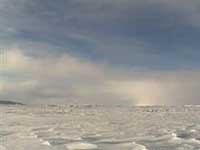Russian mini-subs prepare for descent to sea bed beneath the North Pole
Two miniature submarines Thursday morning prepared to descend more than 2 1/2 miles (4 kilometers) beneath the ice at the North Pole, according to Russian television.

The crew planned to drop a titanium capsule containing the nation's flag on the sea floor, symbolically claiming almost half of the polar region for Moscow.
In a feat mixing science, exploration and the scramble for potential oil and gas fields, the sub crews are attempting what Russian authorities called the first dive of its kind to the ocean floor at Earth's northernmost point.
The MIR subs and their three-member crews planned to plunge into the murky depths and spend several hours conducting the first close-up survey of the geologic structure of the seabed at the pole, according to Russia's Institute of the Arctic and Antarctic, which organized the expedition. The operation was expected to take eight hours.
The subs, two of only five manned submersibles in the world that can dive beyond 3,000 meters (9,840 feet), are expected to return to the surface and their mammoth mother ship, the research vessel Akademik Fyodorov. One of the vehicles was featured in the 1997 movie "Titanic."
Among those aboard the lead sub is Artur Chilingarov, a famed Soviet and Russian polar explorer. He became a hero of the Soviet Union in the 1980s, after leading an expedition aboard a research vessel trapped in Antarctic sea ice, and is currently a deputy speaker of Russia's lower house of parliament.
"I'm not going to lie, of course it's dangerous," the 68-year-old Chilingarov said on Russian television, in video broadcast Thursday morning.
The dive was planned to help map the Lomonosov ridge, a 1,240-mile (1,995-kilometer) underwater mountain range that crosses the polar region. The ridge was discovered by the Soviets in 1948 and named after a famed 18th-century Russian scientist, Mikhail Lomonosov.
In December 2001, Moscow claimed that the ridge was an extension of the Eurasian continent, and therefore part of Russia's continental shelf under international law. The U.N. rejected Moscow's application, citing lack of evidence, but Russia is set to resubmit it in 2009.
If recognized, the claim would give Russia control of more than 460,000 square miles (1.2 million square kilometers), representing almost half of the Arctic seabed. Little is known about the ocean floor near the pole, but by some estimates it could contain vast oil and gas deposits.
The voyage has some scientific goals, including studies of the climate and biology of the polar region. But its chief aim appears to be to advance Russia's political and economic influence by strengthening its legal claims to the Arctic.
"I think that one of the tasks, at least for public consumption, is to put a claim and enlarge our territory by achieving the recognition of the Arctic shelf as a continuation of Russia's Eurasian part," Sergei Pryamikov, director of the international department of the St. Petersburg-based institute, told Russia's RTR television Wednesday.
The U.S. State Department noted that Russia has not yet made public the data from its research, and said the best available scientific evidence suggests the Lomonosov ridge is oceanic by nature "and thus not part of any country's continental shelf."
"While the United States remains skeptical, we have not had the opportunity to examine any of the recently obtained data," said Leslie Phillips, a department spokeswoman. "We wish the Russian scientists a safe expedition."
The U.S. Senate has not yet ratified U.S. accession to the Law of the Sea, which would give Washington a seat on the panel that will consider and eventually rule on the Russian claim.
Phillips said the Bush administration would continue to press hard for ratification in order to give the United States a voice on the commission.
George Newton, former head of U.S. Arctic Research Commission, called the Russian Arctic claim "significant" in an interview on WAMU radio in Washington, D.C.
"With this ability now to mount a more aggressive research program Russia has made efforts to confirm or get additional data that will enable them to resubmit the claim," he said.
Newton, who served 25 years in the U.S. Navy as a submarine officer, said the Russian mini-subs will face dangers, such as a possible change in weather.
"The character of the ocean surface, the ice that is on the ocean surface can change dramatically, a storm can arise," Newton told WAMU. "It's not a trivial effort."
In the coming weeks, expedition researchers plan to set up an Arctic research camp near the pole, called a "drift station" because it will drift with the shifting ice pack in the polar sea, to carry out long-range climate studies. The Akademik Fyodorov is expected to remain in the region until mid-September.
Subscribe to Pravda.Ru Telegram channel, Facebook, RSS!


